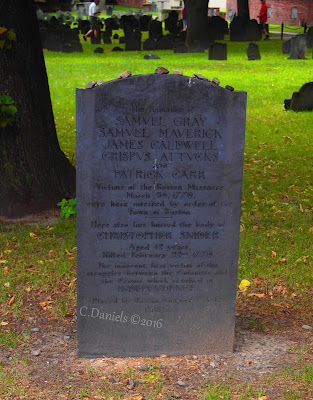It was a late August morning in Boston, steamy and damp with persistent drizzle. I knew the general location of my first stop. But rounding the corner, I hadn't expected it to be so close. Just down the street from my hotel, about a block, across from the next intersection, I could see the marble entry and trees along an iron fence. Realizing what my eyes were registering made me stop in surprise. Even in the rain it resonated as a sacred place.
For decades, since I was in my teens, I had heard of this piece of land, the final resting place of many of the men and women recognized as instigators of revolution. The Granary Burying Ground. How many times had I read that title, and spied it on an old map, wishing I could see it for myself? Too many times to count.
I approached the Egyptian style archway, mentally noting its echo of a time period that was more contemporary. It looked out of place knowing the age of the gravestones inside the gate. People were coming and going, through the imposing arch, despite the drizzle. Once inside, the multitude of carved stones took my breath away. I stood next to an unsuspecting tour guide, half listening to his speech, while clicking away with my camera. I knew enough not to be rude and try to get a freebie tour without paying, so I moved along. After all, I didn't need a tour guide to tell me about this place.
Ironically, or fatefully, I turned in the exact direction I needed to go. I only walked a little ways along the right front path, and there they were, under an old tree. One stone to mark them all. Despite their deaths occurring in 1770, I knew them all by name, my history equivalent of the Beatles: Samuel, Crispus, Patrick, James, and Samuel.
The "victims" of the Boston Massacre have earned quotation marks from historians because of the questionable nature in which they died. Were they victims standing up for freedom's cause? Were they rabble, stirring up trouble and getting rowdy at any chance? I tend to think of them as victims of circumstance. Forces they could not see creating a perfect storm of resentment and hostility. At the very least, they were resisting a military presence in their city, and they did not expect to die that night.
After years of reading trial transcripts, autopsy reports, and commemorative orations, I figured I was the only one who would be excited about finding their grave in this most famous of burial sites. But I was wrong. As I stood in the drizzle, and just silently took in the scene, the pebbles lined up on top of the stone brought tears. Physical evidence that others remember their story and mark the visit with a solemn placement of stone.
I turned to move on and encountered THE Samuel Adams. A rounded, carved stone placed there by the SAR, also covered in small stones of remembrance. It was not grand nor ostentatious, but it was solid, like the personality it memorialized.
The path continued on, and so did I...taking in the artistry of each stone. Time had worn the iconography and some of the letters, but the solemn purpose remained. For those buried in the majority of these graves, death was viewed as something of a stalker, always ready to pounce on the next victim. Each stone contained imagery that served as something of a 17th century PSA, reminding visitors that life was fleeting.
As I roamed, I came across other men of note: Paul Revere, John Hancock, James Otis, Robert Treat Paine, William Molineux, Christopher Snider....and others....men and women who got this party started! Most with only humble stones to mark their existence - except for Mr. Hancock, of course. (1896 replacement stone is quite large.) As the humble nature of the stones reminded me of the fundamental principles our freedom was founded upon, I realized my gratitude grew...inspiring me to share their story at every opportunity.
In a glimmer of hope, I noticed, among the dead, there was a pulse of life. Tour guides in colorful dress entertained tourists with the vibrant stories of those who inhabit the Granary. It is the power of the story that connects us to each other, despite the passage of time. I was pleased to see the story used to bring the dead back to life as the Granary maintained a memorial that was not just stone, but life renewed with each child that came through the gates to learn about our past. Reminding us all that while life may be fleeting, our stories keep living, as long as we tell them.
























